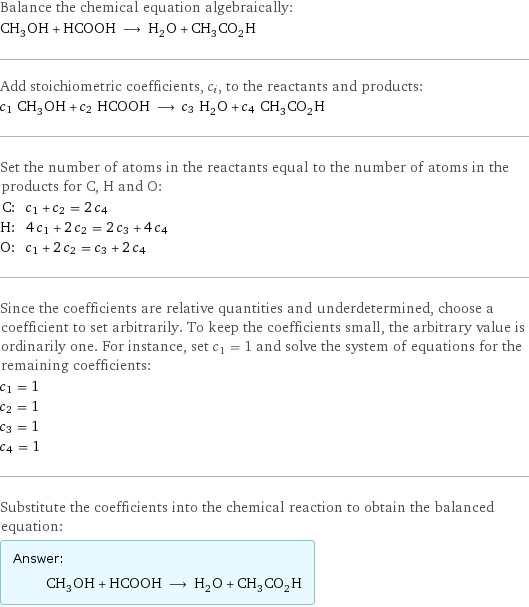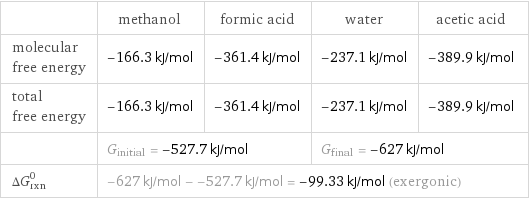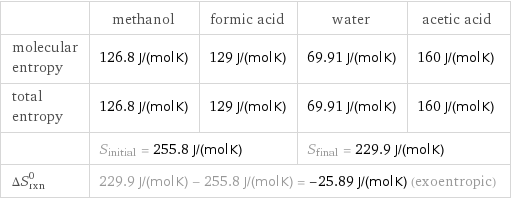Input interpretation

CH_3OH methanol + HCOOH formic acid ⟶ H_2O water + CH_3CO_2H acetic acid
Balanced equation

Balance the chemical equation algebraically: CH_3OH + HCOOH ⟶ H_2O + CH_3CO_2H Add stoichiometric coefficients, c_i, to the reactants and products: c_1 CH_3OH + c_2 HCOOH ⟶ c_3 H_2O + c_4 CH_3CO_2H Set the number of atoms in the reactants equal to the number of atoms in the products for C, H and O: C: | c_1 + c_2 = 2 c_4 H: | 4 c_1 + 2 c_2 = 2 c_3 + 4 c_4 O: | c_1 + 2 c_2 = c_3 + 2 c_4 Since the coefficients are relative quantities and underdetermined, choose a coefficient to set arbitrarily. To keep the coefficients small, the arbitrary value is ordinarily one. For instance, set c_1 = 1 and solve the system of equations for the remaining coefficients: c_1 = 1 c_2 = 1 c_3 = 1 c_4 = 1 Substitute the coefficients into the chemical reaction to obtain the balanced equation: Answer: | | CH_3OH + HCOOH ⟶ H_2O + CH_3CO_2H
Structures

+ ⟶ +
Names

methanol + formic acid ⟶ water + acetic acid
Reaction thermodynamics
Gibbs free energy

| methanol | formic acid | water | acetic acid molecular free energy | -166.3 kJ/mol | -361.4 kJ/mol | -237.1 kJ/mol | -389.9 kJ/mol total free energy | -166.3 kJ/mol | -361.4 kJ/mol | -237.1 kJ/mol | -389.9 kJ/mol | G_initial = -527.7 kJ/mol | | G_final = -627 kJ/mol | ΔG_rxn^0 | -627 kJ/mol - -527.7 kJ/mol = -99.33 kJ/mol (exergonic) | | |
Entropy

| methanol | formic acid | water | acetic acid molecular entropy | 126.8 J/(mol K) | 129 J/(mol K) | 69.91 J/(mol K) | 160 J/(mol K) total entropy | 126.8 J/(mol K) | 129 J/(mol K) | 69.91 J/(mol K) | 160 J/(mol K) | S_initial = 255.8 J/(mol K) | | S_final = 229.9 J/(mol K) | ΔS_rxn^0 | 229.9 J/(mol K) - 255.8 J/(mol K) = -25.89 J/(mol K) (exoentropic) | | |
Equilibrium constant
![Construct the equilibrium constant, K, expression for: CH_3OH + HCOOH ⟶ H_2O + CH_3CO_2H Plan: • Balance the chemical equation. • Determine the stoichiometric numbers. • Assemble the activity expression for each chemical species. • Use the activity expressions to build the equilibrium constant expression. Write the balanced chemical equation: CH_3OH + HCOOH ⟶ H_2O + CH_3CO_2H Assign stoichiometric numbers, ν_i, using the stoichiometric coefficients, c_i, from the balanced chemical equation in the following manner: ν_i = -c_i for reactants and ν_i = c_i for products: chemical species | c_i | ν_i CH_3OH | 1 | -1 HCOOH | 1 | -1 H_2O | 1 | 1 CH_3CO_2H | 1 | 1 Assemble the activity expressions accounting for the state of matter and ν_i: chemical species | c_i | ν_i | activity expression CH_3OH | 1 | -1 | ([CH3OH])^(-1) HCOOH | 1 | -1 | ([HCOOH])^(-1) H_2O | 1 | 1 | [H2O] CH_3CO_2H | 1 | 1 | [CH3CO2H] The equilibrium constant symbol in the concentration basis is: K_c Mulitply the activity expressions to arrive at the K_c expression: Answer: | | K_c = ([CH3OH])^(-1) ([HCOOH])^(-1) [H2O] [CH3CO2H] = ([H2O] [CH3CO2H])/([CH3OH] [HCOOH])](../image_source/ade8138e6dae8c6ec13be14ad7c2d36c.png)
Construct the equilibrium constant, K, expression for: CH_3OH + HCOOH ⟶ H_2O + CH_3CO_2H Plan: • Balance the chemical equation. • Determine the stoichiometric numbers. • Assemble the activity expression for each chemical species. • Use the activity expressions to build the equilibrium constant expression. Write the balanced chemical equation: CH_3OH + HCOOH ⟶ H_2O + CH_3CO_2H Assign stoichiometric numbers, ν_i, using the stoichiometric coefficients, c_i, from the balanced chemical equation in the following manner: ν_i = -c_i for reactants and ν_i = c_i for products: chemical species | c_i | ν_i CH_3OH | 1 | -1 HCOOH | 1 | -1 H_2O | 1 | 1 CH_3CO_2H | 1 | 1 Assemble the activity expressions accounting for the state of matter and ν_i: chemical species | c_i | ν_i | activity expression CH_3OH | 1 | -1 | ([CH3OH])^(-1) HCOOH | 1 | -1 | ([HCOOH])^(-1) H_2O | 1 | 1 | [H2O] CH_3CO_2H | 1 | 1 | [CH3CO2H] The equilibrium constant symbol in the concentration basis is: K_c Mulitply the activity expressions to arrive at the K_c expression: Answer: | | K_c = ([CH3OH])^(-1) ([HCOOH])^(-1) [H2O] [CH3CO2H] = ([H2O] [CH3CO2H])/([CH3OH] [HCOOH])
Rate of reaction
![Construct the rate of reaction expression for: CH_3OH + HCOOH ⟶ H_2O + CH_3CO_2H Plan: • Balance the chemical equation. • Determine the stoichiometric numbers. • Assemble the rate term for each chemical species. • Write the rate of reaction expression. Write the balanced chemical equation: CH_3OH + HCOOH ⟶ H_2O + CH_3CO_2H Assign stoichiometric numbers, ν_i, using the stoichiometric coefficients, c_i, from the balanced chemical equation in the following manner: ν_i = -c_i for reactants and ν_i = c_i for products: chemical species | c_i | ν_i CH_3OH | 1 | -1 HCOOH | 1 | -1 H_2O | 1 | 1 CH_3CO_2H | 1 | 1 The rate term for each chemical species, B_i, is 1/ν_i(Δ[B_i])/(Δt) where [B_i] is the amount concentration and t is time: chemical species | c_i | ν_i | rate term CH_3OH | 1 | -1 | -(Δ[CH3OH])/(Δt) HCOOH | 1 | -1 | -(Δ[HCOOH])/(Δt) H_2O | 1 | 1 | (Δ[H2O])/(Δt) CH_3CO_2H | 1 | 1 | (Δ[CH3CO2H])/(Δt) (for infinitesimal rate of change, replace Δ with d) Set the rate terms equal to each other to arrive at the rate expression: Answer: | | rate = -(Δ[CH3OH])/(Δt) = -(Δ[HCOOH])/(Δt) = (Δ[H2O])/(Δt) = (Δ[CH3CO2H])/(Δt) (assuming constant volume and no accumulation of intermediates or side products)](../image_source/fa38c7fbed8373d43a2bca178cd8cc25.png)
Construct the rate of reaction expression for: CH_3OH + HCOOH ⟶ H_2O + CH_3CO_2H Plan: • Balance the chemical equation. • Determine the stoichiometric numbers. • Assemble the rate term for each chemical species. • Write the rate of reaction expression. Write the balanced chemical equation: CH_3OH + HCOOH ⟶ H_2O + CH_3CO_2H Assign stoichiometric numbers, ν_i, using the stoichiometric coefficients, c_i, from the balanced chemical equation in the following manner: ν_i = -c_i for reactants and ν_i = c_i for products: chemical species | c_i | ν_i CH_3OH | 1 | -1 HCOOH | 1 | -1 H_2O | 1 | 1 CH_3CO_2H | 1 | 1 The rate term for each chemical species, B_i, is 1/ν_i(Δ[B_i])/(Δt) where [B_i] is the amount concentration and t is time: chemical species | c_i | ν_i | rate term CH_3OH | 1 | -1 | -(Δ[CH3OH])/(Δt) HCOOH | 1 | -1 | -(Δ[HCOOH])/(Δt) H_2O | 1 | 1 | (Δ[H2O])/(Δt) CH_3CO_2H | 1 | 1 | (Δ[CH3CO2H])/(Δt) (for infinitesimal rate of change, replace Δ with d) Set the rate terms equal to each other to arrive at the rate expression: Answer: | | rate = -(Δ[CH3OH])/(Δt) = -(Δ[HCOOH])/(Δt) = (Δ[H2O])/(Δt) = (Δ[CH3CO2H])/(Δt) (assuming constant volume and no accumulation of intermediates or side products)
Chemical names and formulas

| methanol | formic acid | water | acetic acid formula | CH_3OH | HCOOH | H_2O | CH_3CO_2H Hill formula | CH_4O | CH_2O_2 | H_2O | C_2H_4O_2 name | methanol | formic acid | water | acetic acid